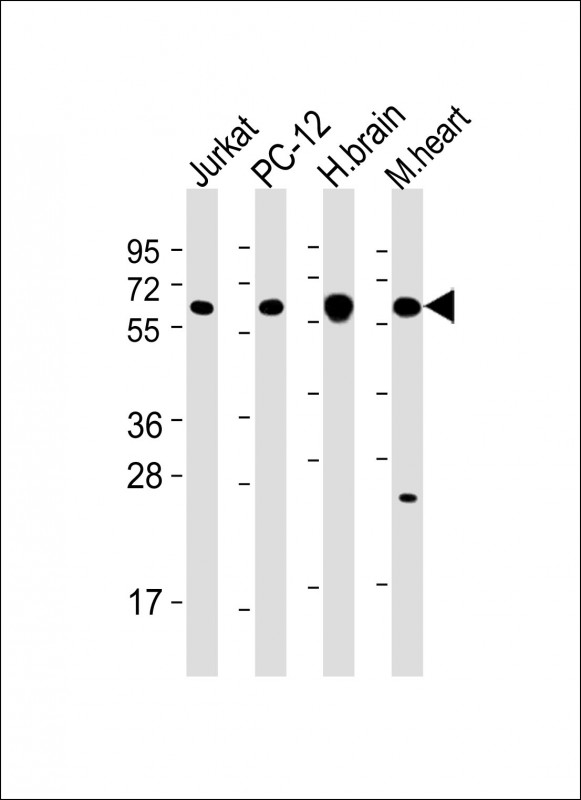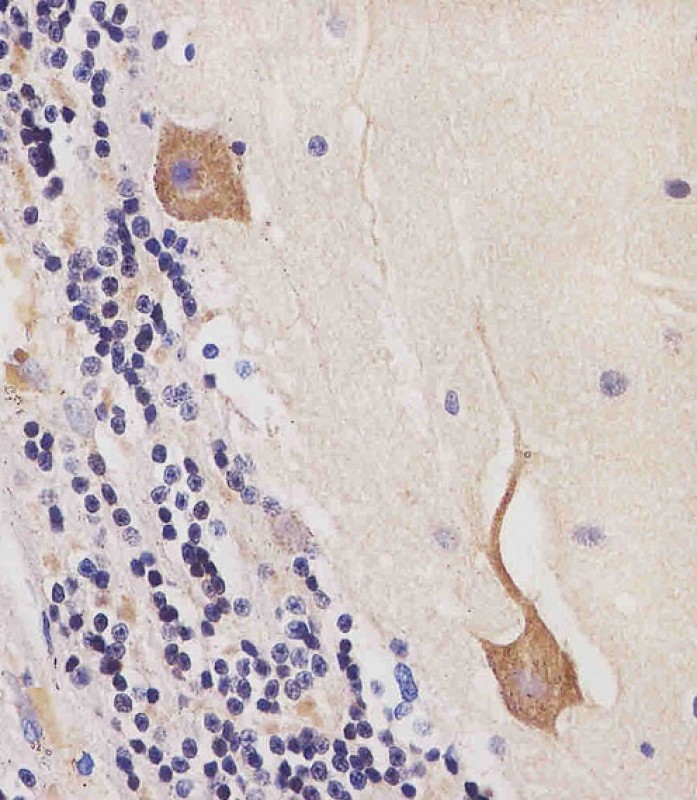

| WB | 1/2000 | Human,Mouse,Rat |
| IF | 咨询技术 | Human,Mouse,Rat |
| IHC | 1/100-1/500 | Human,Mouse,Rat |
| ICC | 技术咨询 | Human,Mouse,Rat |
| FCM | 咨询技术 | Human,Mouse,Rat |
| Elisa | 咨询技术 | Human,Mouse,Rat |
| Aliases | Calcium/calmodulin-dependent protein kinase type II subunit beta, CaM kinase II subunit beta, CaMK-II subunit beta, 2.7.11.17, CAMK2B, CAM2, CAMK2, CAMKB |
| Entrez GeneID | 816 |
| WB Predicted band size | 72.7kDa |
| Host/Isotype | Mouse IgG1 |
| Antibody Type | Primary antibody |
| Storage | Store at 4°C short term. Aliquot and store at -20°C long term. Avoid freeze/thaw cycles. |
| Species Reactivity | Human, Mouse, Rat |
| Immunogen | This CAMK2 beta antibody is generated from a mouse immunized with a recombinant protein between 1-503 amino acids from human CAMK2 beta. |
+ +
以下是关于CaMKIIβ抗体的3篇参考文献示例,包含文献名称、作者及摘要内容概括:
---
1. **"Autophosphorylation-dependent Targeting of Calcium/Calmodulin-Dependent Protein Kinase II by the AP2 μ-Clathrin Adaptor Complex"**
*Bayer, K.U., et al. (2002)*
该研究利用CaMKIIβ特异性抗体,揭示了自磷酸化调控CaMKIIβ与突触后膜结合的机制,发现其通过AP2复合物介导的网格蛋白依赖途径实现亚细胞定位。
---
2. **"Distinct Structural and Calcium/Calmodulin Regulation of CaMKIIβ in Transgenic Mice"**
*Elgersma, Y., et al. (1999)*
通过CaMKIIβ抗体检测突变体蛋白表达,发现β亚基的C端结构域对其突触靶向及功能至关重要,突变导致小鼠突触可塑性和记忆形成受损。
---
3. **"Dynamic Control of CaMKII Translocation and Localization in Living Cells"**
*Shen, K., & Meyer, T. (1999)*
结合抗体标记与活细胞成像技术,阐明CaMKIIβ在钙信号激活下的动态分布规律,揭示其从胞质向树突棘快速迁移的分子机制。
---
4. **"CaMKIIβ Association with the NMDA Receptor is Regulated by Oxidation"**
*Hudmon, A., et al. (2005)*
研究使用特异性抗体证明,氧化应激通过修饰CaMKIIβ的甲硫氨酸残基,增强其与NMDA受体的结合能力,从而调控突触信号传递。
---
注:以上文献信息为示例,实际引用时需核对具体发表年份及作者全名。若需近年研究,可补充关键词(如"CaMKIIβ antibody 2020+")检索最新成果。
The CAMK2β (Calcium/Calmodulin-Dependent Protein Kinase II Beta) antibody is a crucial tool for studying the function and expression of the CAMK2β protein, a member of the Ca²⁺/calmodulin-dependent kinase family. CAMK2β plays a pivotal role in calcium-mediated signaling pathways, particularly in the brain, where it regulates synaptic plasticity, neuronal development, and memory formation. It exists as part of a multimeric holoenzyme, often forming heteromeric complexes with other isoforms (e.g., CAMK2α). Unlike CAMK2α, which is predominantly expressed in excitatory neurons, CAMK2β is more widely distributed across tissues, including the heart and immune cells, and is implicated in diverse cellular processes such as cytoskeletal reorganization and gene transcription.
Antibodies targeting CAMK2β enable researchers to detect and quantify the protein in various experimental settings, including Western blotting, immunohistochemistry, and immunofluorescence. These antibodies are essential for investigating CAMK2β's post-translational modifications (e.g., autophosphorylation at Thr287) and its dynamic activation in response to calcium signaling. Dysregulation of CAMK2β has been linked to neurological disorders (e.g., Alzheimer’s disease, autism spectrum disorders) and cardiac arrhythmias, making its study clinically relevant. Validation of CAMK2β antibodies typically involves knockout controls or isoform-specificity tests to ensure minimal cross-reactivity with other CAMK2 family members. Ongoing research continues to explore its dual roles as a kinase and a structural scaffold in cellular signaling networks.
×